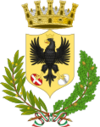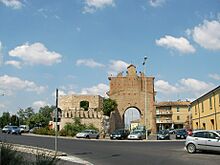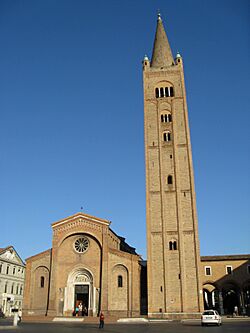Forlì facts for kids
Quick facts for kids
Forlì
Furlè (Romagnol)
|
|||
|---|---|---|---|
| Comune di Forlì | |||

Piazza Saffi
|
|||
|
|||
| Country | Italy | ||
| Region | Emilia-Romagna | ||
| Province | Forlì-Cesena (FC) | ||
| Frazioni | see list | ||
| Area | |||
| • Total | 228.2 km2 (88.1 sq mi) | ||
| Elevation | 34 m (112 ft) | ||
| Population
(31 May 2022)
|
|||
| • Total | 116,700 | ||
| • Density | 511.4/km2 (1,324.5/sq mi) | ||
| Demonym(s) | Forlivesi | ||
| Time zone | UTC+1 (CET) | ||
| • Summer (DST) | UTC+2 (CEST) | ||
| Postal code |
47121-47122
|
||
| Dialing code | 0543 | ||
| Patron saint | Beata Vergine del Fuoco | ||
| Saint day | February 4 | ||
Forlì (/fɔːrˈliː/ FOR-lee; Italian: [forˈli]; Romagnol: Furlè [furˈlɛ]; Latin: Forum Livii) is a city in Emilia-Romagna, Northern Italy. It is the capital of the Province of Forlì-Cesena, shared with Cesena. Forlì is also the main city in the Romagna region.
| Historical population | ||
|---|---|---|
| Year | Pop. | ±% |
| 1861 | 37,477 | — |
| 1871 | 38,639 | +3.1% |
| 1881 | 40,915 | +5.9% |
| 1901 | 43,321 | +5.9% |
| 1911 | 45,723 | +5.5% |
| 1921 | 51,555 | +12.8% |
| 1931 | 60,140 | +16.7% |
| 1936 | 65,683 | +9.2% |
| 1951 | 77,508 | +18.0% |
| 1961 | 91,945 | +18.6% |
| 1971 | 104,971 | +14.2% |
| 1981 | 110,806 | +5.6% |
| 1991 | 109,541 | −1.1% |
| 2001 | 108,335 | −1.1% |
| 2011 | 116,434 | +7.5% |
| 2021 | 116,558 | +0.1% |
| Source: ISTAT | ||
The city is located along the Via Emilia, a historic Roman road. It sits east of the Montone river. Forlì is an important center for farming and agriculture. It is also known as the birthplace of famous painters like Melozzo da Forlì and Marco Palmezzano. Many other important people, including historians and doctors, were also born here.
Forlì is home to a campus of the University of Bologna. This campus specializes in subjects like Economics, Engineering, and Political Sciences. It also has a special school for learning modern languages for interpreters and translators.
Contents
What's the Weather Like in Forlì?
The climate in Forlì is generally humid subtropical. This means it has hot, sunny summers and cool, moist winters. The city is close enough to the sea that the weather is a bit milder.
Summer Weather
Summers in Forlì are hot and sunny. Temperatures can often go above 30 °C (86 °F). During the hottest parts of the year, they can even reach 40 °C (104 °F).
Winter Weather
Winters are cool and damp. Fog is common during these months. Sometimes, a warm wind called the Sirocco blows from the south. This wind brings warmer temperatures for short periods.
| Climate data for Forlì (1991–2020) | |||||||||||||
|---|---|---|---|---|---|---|---|---|---|---|---|---|---|
| Month | Jan | Feb | Mar | Apr | May | Jun | Jul | Aug | Sep | Oct | Nov | Dec | Year |
| Mean daily maximum °C (°F) | 7.4 (45.3) |
9.9 (49.8) |
14.5 (58.1) |
18.6 (65.5) |
23.6 (74.5) |
28.3 (82.9) |
30.7 (87.3) |
30.3 (86.5) |
25.0 (77.0) |
19.2 (66.6) |
12.9 (55.2) |
8.0 (46.4) |
19.0 (66.3) |
| Daily mean °C (°F) | 4.2 (39.6) |
5.6 (42.1) |
9.7 (49.5) |
13.8 (56.8) |
18.4 (65.1) |
22.8 (73.0) |
25.1 (77.2) |
24.9 (76.8) |
20.3 (68.5) |
15.2 (59.4) |
9.9 (49.8) |
5.0 (41.0) |
14.6 (58.2) |
| Mean daily minimum °C (°F) | 1.1 (34.0) |
1.4 (34.5) |
5.0 (41.0) |
9.0 (48.2) |
13.2 (55.8) |
17.3 (63.1) |
19.5 (67.1) |
19.5 (67.1) |
15.4 (59.7) |
11.3 (52.3) |
6.8 (44.2) |
2.0 (35.6) |
10.1 (50.2) |
| Average precipitation mm (inches) | 43.8 (1.72) |
53.9 (2.12) |
60.9 (2.40) |
65.5 (2.58) |
64.7 (2.55) |
48.3 (1.90) |
41.0 (1.61) |
57.8 (2.28) |
74.6 (2.94) |
87.0 (3.43) |
96.3 (3.79) |
66.7 (2.63) |
760.5 (29.95) |
| Source: Arpae Emilia-Romagna | |||||||||||||
A Look at Forlì's History
Ancient Times: How Forlì Began
People have lived around Forlì for a very long time. Tools made from stone, dating back 800,000 years, have been found nearby. This shows that early humans lived and worked here.
Forlì was founded after the Romans took over the local Gallic villages. This happened around the time the Via Aemilia road was built. Some historians believe the city was founded in 188 BC. It was named Forum Livii, meaning "the place of the gens Livia". This name likely came from a Roman leader named Gaius Livius Salinator. The city was destroyed in 88 BC during Roman civil wars but was later rebuilt.
The Middle Ages: Forlì as a City-State
After the Western Roman Empire fell, Forlì became part of different kingdoms. From the late 500s to 751, it was part of the Byzantine Empire's rule in Italy. During this time, the Germanic Lombards took the city several times. In 757, it became part of the Papal States, which were lands ruled by the Pope.
By the 800s, Forlì became an independent city-state. This was a time when cities in Italy started to govern themselves. Forlì became a republic in 889. It often sided with the Ghibelline group in the fights between the Guelphs and Ghibellines. This was a way for the city to keep its independence. Forlì supported the Holy Roman Emperors in their Italian campaigns.
In 1241, Forlì helped Frederick II capture the city of Faenza. As a thank you, Forlì was allowed to add the Hohenstaufen eagle to its coat of arms. After Frederick II's power weakened in 1257, a leader named Guido I da Montefeltro took refuge in Forlì. He became the "Captain of the People" and led Forlì to important victories against its enemies. The famous poet Dante Alighieri even mentioned one of these battles in his work Inferno.
Later, the city came under the rule of local powerful families, called condottiere. The Ordelaffi family came to power in 1302. They tried to keep control of Forlì and its surrounding areas. They often fought against the Pope's attempts to regain authority. Sometimes, members of the Ordelaffi family even fought each other.
Modern Times: Changes and Challenges
A famous Ordelaffi ruler was Pino III, who ruled from 1466 to 1480. He was a tough leader but made the city richer with new walls and buildings. He also supported the arts. After his death, the city became weaker due to family fights.
In 1488, the Visconti family took control. Then, in 1499, Cesare Borgia seized Forlì. After his death, the city became more directly controlled by the Pope.
In June 1796, during the French Revolution, French troops entered Forlì. Napoleon himself arrived in February 1797. This led to political changes and unrest in the city. There were uprisings in 1821, 1831, and 1848.
In the 1800s, Forlì was part of the Italian unification movement, also called the "Risorgimento". This movement aimed to unite the different states of Italy into one country. The people of Forlì were inspired by military leaders like Giuseppe Garibaldi. However, the city and its farmers found it hard to adapt to new farming rules after unification. This led to the rise of republican and socialist political groups.
Forlì played a big part in World War I. After the war, in the 1920s, Benito Mussolini became involved in local politics. He later became the dictator of Italy. World War II caused a lot of damage to Forlì. Many monuments and artworks were destroyed. For example, the Church of San Biagio lost its beautiful frescoes. After the war, the city quickly recovered and began a new period of democratic life.
Forlì's Economy
Forlì is a busy center for both farming and industry. Its factories mainly produce silk, rayon, clothing, machines, metals, and home appliances. The Ferretti Group, a famous company that builds yachts, also has its headquarters in Forlì.
Main Sights and Attractions
Forlì has many important buildings that are interesting for their architecture, art, and history.
Piazza Aurelio Saffi
At the heart of the city is the Piazza Aurelio Saffi. This square has a statue of Aurelio Saffi, an important Italian politician. He was a key figure in the movement to unite Italy in the 1800s.
Abbey of San Mercuriale
The Piazza Saffi also features the Abbey of San Mercuriale. This is the main religious building in Forlì. It is named after Saint Mercurialis, a bishop of the city who died in the 400s. Inside, you can find the famous tomb of Barbara Manfredi.
Other Notable Buildings
- The Dominican Church of San Giacomo Apostolo, also known as the Church of San Domenico, is a medieval church built in the 1200s.
- The Rocca di Ravaldino is a fortress that was made larger in the 1300s and 1400s.
- The Palazzo Hercolani has beautiful decorations from the 1800s. It contains a painting called La Beata Vergine del Fuoco con i Santi Mercuriale, Pellegrino, Marcolino e Valeriano by Italian painter Pompeo Randi.
- The Palazzo del Podestà is a civic building with frescoes by Adolfo de Carolis from the 1900s.
Parks and Entertainment
Forlì has lovely green spaces, including the Parco della Resistenza ("Resistance Park"). The Parco di Via Dragoni offers places for performances and other activities. The Teatro Diego Fabbri is a theatre that opened in 2000.
Territorial Subdivisions
Forlì is divided into smaller areas called frazioni.
Villafranca di Forlì
Villafranca di Forlì is a small village that is part of the Forlì municipality. It is located north of the main city, next to the River Montone. This village is where Benito Mussolini's mother, Rosa, was born.
Near Villafranca, there is a small airfield. It has a runway about 800 metres (2,600 ft) long. This airfield is used for light aircraft and model planes. It is also home to a flight school for the Civil Defence. This small airfield helps support Forlì's main airport, which is south of the city.
Other frazioni
- Bagnolo
- Barisano
- Borgo Sisa
- Branzolino
- Carpena
- Carpinello
- Casemurate
- Caserma
- Castiglione
- Ca'Ossi
- Cava
- Collina
- Coriano
- Durazzanino
- Forniolo
- Grisignano
- Ladino
- Magliano
- Malmissole
- Massa
- Ospedaletto
- Para
- Pescaccia
- Petrignone
- Pianta
- Pieve Acquedotto
- Pievequinta
- Poggio
- Ponte Vico
- Quattro
- Ravaldino in Monte
- Romiti
- Roncadello
- Ronco
- Rotta
- Rovere
- San Giorgio
- San Leonardo in Schiova
- San Lorenzo in Noceto
- San Martino in Strada
- San Martino in Villafranca
- San Tomé
- San Varano
- Vecchiazzano
- Villa Rovere
- Villa Selva
- Villagrappa
- Villanova
Getting Around Forlì
Train Travel
The Forlì railway station is on the Bologna–Ancona train line. The current station opened in 1926. It replaced an older station that had been in use since 1861. The original station building still stands nearby.
Forlì Airport
Forlì Airport was closed in 2013 because the company running it went out of business. However, flights started again at the airport on October 29, 2020.
Famous People from Forlì
Many talented people have come from Forlì.
Artists and Musicians
- Melozzo da Forlì was a very famous painter from Forlì. He worked in Rome and other Italian cities during the High Renaissance.
- Other painters from Forlì include Ansuino da Forlì, Marco Palmezzano, Francesco Menzocchi, and Livio Agresti. They were part of the Forlì painting school.
- Carlo Cignani was born near Forlì and created important artworks there.
- Alice is an Italian singer who won the Sanremo Festival.
- Marco Sabiu is a musician and composer.
- Giovanni Battista Cirri and Ignazio Cirri were cellists and composers in the 1700s.
- Alessandro Cortini is a keyboard player for the band Nine Inch Nails.
- Maria Farneti was an opera singer.
- Giulietta Simionato was a famous opera singer.
Other Notable People
- Flavio Biondo was a Renaissance historian.
- Geronimo Mercuriali and Giovanni Battista Morgagni were important doctors.
- Aurelio Saffi was a key political figure in the Italian unification movement.
- Caterina Sforza was a powerful lady who ruled Forlì for a time.
- Pietro Leoni was a Catholic priest who survived the Gulag.
- Loris Reggiani was a motorcycle road racer.
- Vincenzo Sospiri is a race car driver.
- Ilario Bandini built performance sports and race cars.
- Pietro Bandini was a missionary who worked with Italian American immigrants.
- Saint Peregrine Laziosi was a Catholic saint.
International Connections
Twin Towns
Forlì has special friendships with other cities around the world. These are called twin towns:
 Aveiro, Portugal
Aveiro, Portugal Bourges, France
Bourges, France Peterborough, U.K.
Peterborough, U.K. Szolnok, Hungary
Szolnok, Hungary Płock, Poland
Płock, Poland
See also
 In Spanish: Forlì para niños
In Spanish: Forlì para niños
Images for kids







